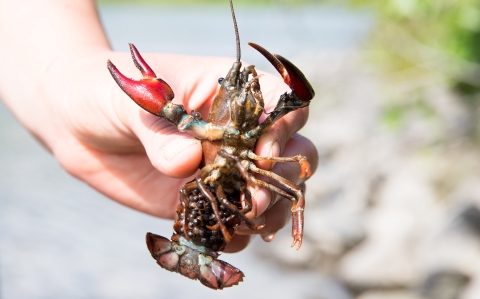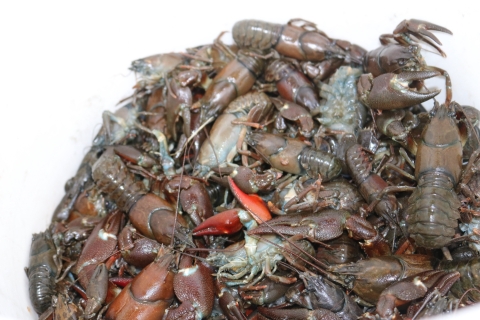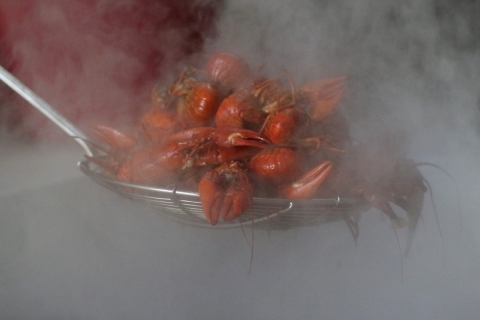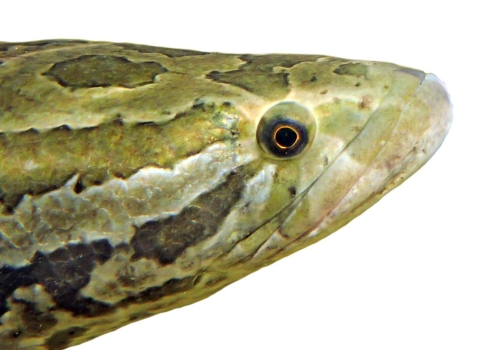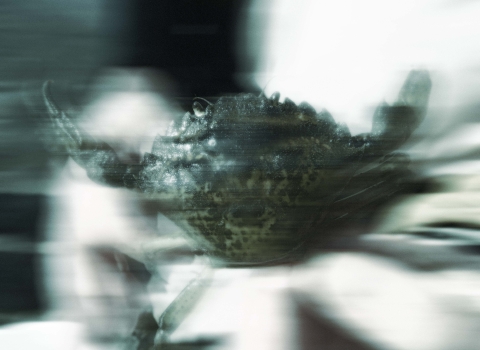Matt van Daele (Sun’aq Tribe of Kodiak), Jeff Woods (crayfish fisherman), and Tammy Davis (Alaska Department of Fish and Game) joined us for a conversation about invasive crayfish on Kodiak Island, Alaska.
Arrival of Crayfish in Alaska
Tammy: We first heard about crayfish on Kodiak Island in 2002 — a student was out fishing in Buskin Lake and found several. That following summer, we did some opportunistic trapping but weren’t that successful.
Matt:Back in 2003, I was a brand new high school intern with Alaska Department of Fish and Game’s Sport Fish division in Kodiak. My buddy and I got sent out to try to trap these crayfish. We got a lot a lot of crushed traps by bears checking them out and trying to get to the bait inside.
Fortunately as years have gone by, folks have gotten very adept at catching crayfish. Jeff was the first student to successfully catch crayfish, including females with eggs.
Jeff: I caught the first one back in high school, completely by accident. I was out with my dad fishing silver salmon by the outlet of Buskin Lake. There was another gentleman sitting next to us who saw something under a rock — he was too scared to grab it. It turned out to be a fairly good-sized signal crayfish, which I later took to my high school natural resource teacher, Jane Iseman.
Signal crayfish are fast-growing and can live up to 20 years. Females start reproducing by age three and have clutches of up to 400 eggs
Why Are They Called Signal Crayfish?
At the joints of their claw, where their pincher and the main part of their claws join that joint, they have a white spot there. It’s kind of their signal.
Where Are They Found Naturally?
Tammy: Their native range is basically the Columbia River Basin. The southernmost populations are in that northwest corner of California. They range up through Oregon and into Washington (although not the Puget Sound area) — even up into British Columbia and a little bit into the panhandle of Idaho. They’ve been introduced into Central California, Nevada, Utah, parts of Oregon, and Alaska [check out this animated map of the spread of signal crayfish].
Have Other Crayfish Species Made it to Alaska?
Tammy: Red swamp crayfish have been found on the Kenai Peninsula. Somebody imported them for a crawfish boil and their young children wanted to save some of the crayfish. So they released them. They didn’t fare very well because they’re some of the more southeastern crayfish—Alaska’s cold waters weren’t suitable.
Sun’aq Got a Tribal Wildlife Grant to Look at Their Distribution, Movement and Diet, Right? What Are You Finding?
Matt: That grant just ended and I’m in the process of writing up the final report right now. We just got a grant from Bureau of Indian Affairs’ invasive species invasive species
An invasive species is any plant or animal that has spread or been introduced into a new area where they are, or could, cause harm to the environment, economy, or human, animal, or plant health. Their unwelcome presence can destroy ecosystems and cost millions of dollars.
Learn more about invasive species program to fund another full season of very concerted efforts to remove as many crayfish as possible. We’re also hoping to better understand where they’re operating on the food chain by using stable isotopes to reconstruct their diet.
What’s Your Biggest Fear About the Introduction of These Crayfish?
Tammy: Like most invasive species, signal crayfish are great at reproducing and pretty easy going in terms of their habitat needs. They eat the aquatic bugs that are really important links in salmon food webs. Some studies have found there can be a 60% reduction in invertebrates due to crayfish predation. That’s pretty significant.
Signal crayfish also carry specific pathogens, namely “crayfish plague.” Since we don’t have native crayfish, we don’t need to worry about that, but it’s a good reminder that anything you release into the wild could carry pathogens and negatively impact native species.
What’s the Crayfish Fishing Situation on Kodiak?
Jeff: In my experience, it hasn’t really taken off. There’s been a few core groups of guys that go out and periodically attempt it. It’s kind of a weekend thing, mostly with traps. I’ve seen where people have made the trap openings too small — you’ll have 60-70 crawfish around the outside of the trap. I think lack of success turned a lot of people off pretty early.
The most efficient way I found to catch crayfish is diving. I’ve caught them as shallow as two inches of water and as deep as 20 feet. I’ve tried walking with just my Xtratufs down the first little portion of Buskin River every year since probably 2017. That year I caught 16 around April. This year: 103 in about three hours.
They Do That Backward Scuttle?
I come from behind them and grab them. I’ve used nets with success and a lot of the crawfish we catch here are actually big enough that they won’t go through the mesh of a normal salmon or steelhead release-type net.
I’ve caught all sizes, from as small as you can see to longer than my hand and wrist from claw tip to the base their tail.
Are They Just in the Buskin River Watershed?
Matt: So far, we know they’re in Buskin Lake and part of the Buskin River. The river itself is about three and a half miles long and there are many tributaries — ample habitat for them to colonize. We’re working to set up an early detection network using “environmental” DNA (eDNA) from water samples to see if we find crayfish DNA in new waters — tough walking, tough hiking, prime bear habitat.
Just the other week, Jeff was telling me he observed strange little holes in another river that looked very much like crayfish burrows. If we get an eDNA monitoring technique going here on Kodiak, when we receive reports from concerned citizens and citizen scientists, we’d be able to do something about it rapidly.
Environmental DNA (eDNA) is found in the environment and comes from cells shed from a kin, excrement, etc.
The problem with crustaceans is they don’t shed as much DNA into the water as other taxa might. So it’s going to take some refining and figuring out the best timing.
How Are People Preparing Crayfish/What’s a Crayfish Boil?
Jeff: Oh they’re tasty. They’re phenomenal eating crawfish at the end of the day. They’re a little sweeter than the swamp crayfish that I grew up catching in the lower 48.
I’ve actually done quite a lot of crayfish boils since 2012. In fact, we had a crayfish boil at our wedding reception. I’ve taken conservatively 800 to 1,500 crayfish out of the Buskin.
It also depends on who you’re talking to — one of the gals in at the Soil and Water Conservation District very much likes the more Swedish method with lots of dill. For me, I take a dozen lemons, cut them in half, put them with some onions and plenty of Tony Chachere’s and call it good.
Tammy: I always like when the invasive species can be turned into food sources, that idea “if you can’t beat it, eat it.”
Do You Suck the Heads?
Jeff: If you don’t, you’re not that into seafood!
Matt: You know, this is a really cruel conversation to be having right before lunch.
What’s Your Take-home About Kodiak’s Crayfish?
Tammy: Don’t release your pets. Don’t do it. The Buskin is a primary sockeye system. I would hate to think that there’ll be a preference for invasive species over our valued and culturally relevant sockeye salmon.
Matt: The Buskin supports the per capita most important subsistence sockeye fishery here in Kodiak and certainly on the Kodiak road system. There have been multiple times in the past when even the subsistence fisheries had to be shut down because of low escapement. Now whether this has anything to do with the crayfish is definitely debatable, but it highlights the importance of this salmon resource for the entire community of Kodiak, and also the fragility of this essential fishery. Introducing something like a crayfish is just one more thing to upset the balance.
What’s the Likelihood of Reducing or Eradicating Crayfish on Kodiak?
Matt: I am optimistic that we could make a dent, but not fully eradicate them. We have community involvement going for us — folks like Jeff are interested and engaged. Tammy and her crew at Alaska Department of Fish and Game are keeping everyone informed.
Tammy: We have an invasive species hotline (1–877 INVASIV) and you can also report invasive species sightings online. You can also contact the ADF&G invasive species program if you’re interested in doing citizen science. During Alaska Invasive Species Awareness Week in June, look for opportunities to engage with your community to learn about invasive species and participate in local events. We ask that you share what you learn with your family, friends and neighbors.



